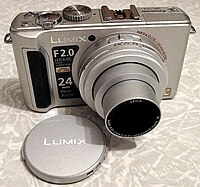Similar cameras
Similar high-end compact cameras are the LX3's sister camera, the Leica D-Lux 4, the Canon PowerShot S90, and the Samsung TL500/EX1. [2] A remarkable quality of the LX3 vs. the S90 is that the aperture of the LX3 only gradually, steadily narrows from 2.0 to 2.8, whereas that for the S90 quickly narrows. (And in later versions, the LX5 retained this gradual narrowing through the extended range (24-90 equiv.); the LX7 retained the extended range and gradual aperture narrowing while opening a full stop wider (1.4 - 2.3!!).)
Leica D-Lux 4
The Leica D-Lux 4 is very similar to the LX3, sharing most of the design and the mechanical components. The main difference is the more pronounced grip on the LX3, the firmware which processes the JPG files in warmer hues on the D-Lux4 and the fact that D-Lux4 comes bundled with Capture One image processing software.
Upgrades
Panasonic has continued to improve the firmware. The v. 2.1 firmware claims improved performance, a 20% improvement in autofocus speed, and new features such as a 1:1 aspect ratio and focus resume. [3]
On July 30, 2010, Panasonic released another firmware update for the LX3. The stated reason behind the update is 'Optimization of software processing', with an additional comment stating 'Change in software version has no effect on camera performance'.
Panasonic launched the successor to the LX3, the LX5, on 21 July 2010. [4]
The latest model features a revised sensor, longer zoom range and improved control layout without fundamentally changing the existing model's formula. It offers a more flexible 24–90 mm equivalent lens with a bright f/2.0–3.3 maximum aperture range and a comparatively large 10MP sensor in a small body. The body itself is barely changed compared to the LX3 – gaining an improved hand grip, clickable control dial, direct movie record button and a 1:1 position on the aspect ratio slider. Most significantly it gains a connector to add the DMW-LVF1 electronic viewfinder originally launched with the GF1. Other than this, the LX5 gains the AVCHD Lite format for its 720p video, and its image stabilization is branded with the company's latest 'Power O.I.S' designation.

The Four Thirds System is a standard created by Olympus and Eastman Kodak for digital single-lens reflex camera (DSLR) and mirrorless camera design and development.
The Leica Digilux 1 is a digital camera developed in partnership with Panasonic, which was released in 2002, roughly the same time as the Canon PowerShot G2 and the Nikon 2000. It is the second of Leica's digital offerings. Where the original Digilux was developed in partnership with Fuji Camera, the Digilux 1 was developed jointly with Panasonic; Leica is responsible for optics, while Panasonic designs the camera electronics. According to Leica, this allows both companies to design cameras that creates a harmonious matching of lens to sensor to produce color and contrast to Leica standards.

Panasonic Lumix DMC-FZ30 is a bridge digital camera by Panasonic. It is the successor of the Panasonic Lumix DMC-FZ20. The highest-resolution pictures it records is 8 megapixels.
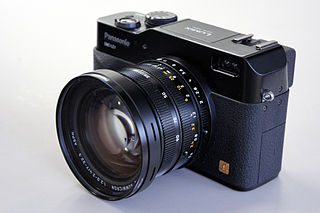
Lumix is Panasonic's brand of digital cameras, ranging from pocket point-and-shoot models to digital SLRs.

The Digilux 3 is a digital single-lens reflex camera introduced by Leica on 14 September 2006. The Digilux 3 and the Panasonic Lumix DMC-L1 are similar specification cameras, using the Four Thirds standard lens mount and featuring a 7.5 Megapixels live view N-MOS sensor, but the Digilux 3 has modified firmware including DNG output. Both the Panasonic and Digilux 3 cameras come standard with the same interchangeable Leica Elmarit 14–50 mm f/2.8–3.5 optically image-stabilized zoom lens. The Leica D system includes also the Leica Summilux 25 mm f/1.4 lens.

Panasonic Lumix DMC-FZ50 is a superzoom bridge digital camera by Panasonic.

The Panasonic Lumix DMC-GH1 is a digital mirrorless interchangeable lens camera adhering to the Olympus and Panasonic developed Micro Four Thirds System (MFT) system design standard. Panasonic classified the GH1 as a hybrid stills/video camera and the GH1 was introduced and marketed as a higher end camera than Panasonic's first MFT camera, the stills only, non-video capable Lumix DMC-G1.

The Canon PowerShot S90 is a high-end 10.0-megapixel compact digital camera originally announced in 2009. The PowerShot S90 is the successor of the Canon PowerShot S80.

The Panasonic Lumix DMC-TZ10 is a compact "Travel Zoom" digital camera released in 2010. It is equipped with a 12x zoom lens, a GPS receiver for geotagging, has 12 Megapixels, and can film at up to 720p resolution at 30 frames per second in MJPEG and AVCHD formats. The camera can be connected to a USB port for file transfer and weighs 218 grams.

The Canon PowerShot S95 is a high-end 10.0-megapixel compact digital camera announced and released in 2010. It was designed as the successor to the Canon PowerShot S90 in the S series of the Canon PowerShot line of cameras.
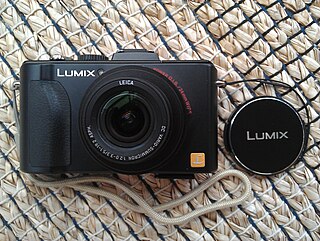
The Panasonic Lumix DMC-LX5, or LX5, is a high-end compact "point and shoot" camera launched by Panasonic in 2010 to succeed the LX3.

The Panasonic Lumix DMC-GH2 is a digital camera with HD video recording capability that is part of the Micro Four Thirds system. Though commonly referred to as a DSLR camera, it has no mirror or optical viewfinder, but has instead both a fold-out LCD screen and a electronic viewfinder.
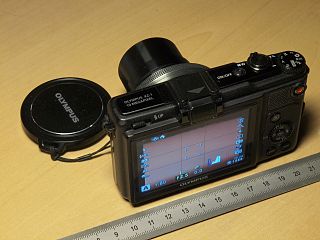
The Olympus XZ-1 is a high-end 10.0 megapixel compact digital camera announced and released in January 2011. Its key features are a fast f/1.8-2.5 i.Zuiko Digital lens, a built in imager shift image stabilizer and Olympus' 6 Art Filters that are also present in the E-PEN series.

The Panasonic Lumix DMC-LX7, or LX7, is a high-end compact "point and shoot" camera launched by Panasonic in 2012 to succeed the LX5.
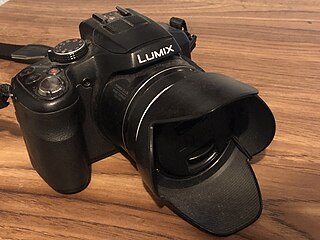
Panasonic Lumix DMC-FZ200 is a digital camera by Panasonic Lumix, which was announced in July 2012. The highest-resolution pictures it records is 12.1 megapixels, through a 25 mm Leica DC Vario-Elmarit.

The Panasonic Lumix DMC-FZ1000 is a digital superzoom bridge camera by Panasonic. It went on sale in June 2014. It has a 20 megapixel 3:2 BSI-CMOS sensor and Leica-branded 25–400 mm equivalent focal length lens with a maximum aperture of f/2.8 to f/4. It has a 1-inch CMOS sensor and supports ISO film speeds from 80 to 25600, shutter speeds from 1/16000 s to 60 s and RAW capture, while the lowest physical shutter speed is 1/4000 s. The unit is equipped with five "Fn" function buttons which can be allocated to custom shortcuts.

The Panasonic Lumix DMC-LX100 is a compact camera with a 13 MP Four Thirds type 17.3mm x 13mm sensor announced by Panasonic on September 15, 2014. LX100 features an F1.7-2.8 24-75mm equivalent Leica-branded lens, 2764k dot Electronic viewfinder, 3" 921k dot LCD, built-in wireless and it can record 4K video at 30p or Full HD at 60p.

The Digilux 2 is a digital camera model sold by Leica Camera, with the body manufactured in Japan by Matsushita, which sold a variant as the Panasonic Lumix DMC-LC1. Its image sensor is a CCD with 5.24 million total pixels. It has a color, transreflective thin-film transistor liquid crystal display with 211,000 pixels, in addition to an electronic viewfinder. It has a near-focus range of 30 centimeters. The camera has a built-in flash. This flash, first of its kind, has the ability to be pointed up, as well as the standard method of pointing straight ahead, in order to "bounce" the light off a ceiling. The camera weighs 630 grams. Its dimensions are 135 millimeters in width, 82 millimeters in height, and 103 millimeters in depth. The camera is fitted with a Leica Vario Summicron lens of f/2 with a zoom function of 28mm - 90mm in 35mm format.

Nocticron is the brand name of Leica lenses with an extreme speed of f/1.2. Because of the large aperture size and its image stabilisation system it is possible to take images with relatively short exposure time especially in available light situations. Together with the high number of nine diaphragm blades the lens creates a strong and pleasant bokeh.
This page is based on this
Wikipedia article Text is available under the
CC BY-SA 4.0 license; additional terms may apply.
Images, videos and audio are available under their respective licenses.
